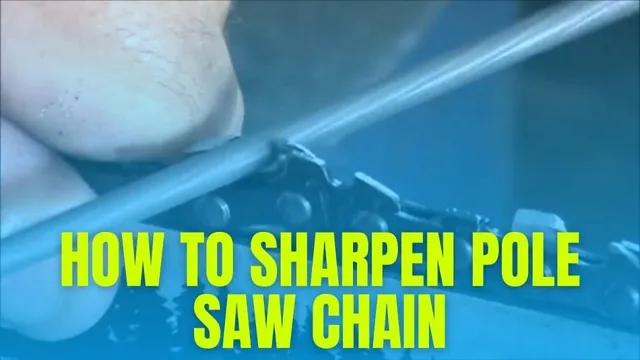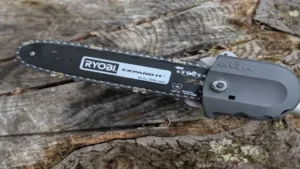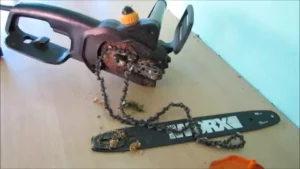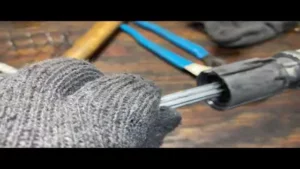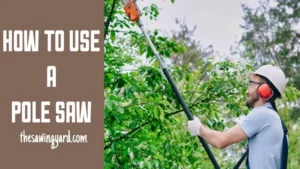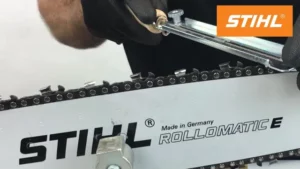Have you noticed that your pole saw isn’t cutting as smoothly as it used to? The culprit could be a dull chain. Don’t worry – sharpening a pole saw chain is easier than you might think. With a few tools and some patience, you can have your pole saw cutting like new in no time.
A pole saw chain is designed to cut through thick branches and limbs, but over time, it can become dull or damaged. When this happens, you may notice that it takes longer to cut through branches, and the saw may kick back or pull to one side. Sharpening the chain is a simple solution that can save you time and effort in the long run.
In this guide, we’ll take you through the steps to sharpen a pole saw chain, from removing the chain to using a file to hone the individual cutters. We’ll cover the tools you’ll need and provide tips for maintaining your chain, so it stays sharp for longer. Whether you’re a seasoned pro or a beginner, you’ll find valuable information here to help you get the most out of your pole saw.
So, grab your tools and let’s get started!
Tools Needed
If you own a pole saw, it’s essential to keep the chain sharp for optimal cutting performance. To sharpen your pole saw chain, you’ll need specific tools. First, you’ll require a round file, which should match the size of the saw chain.
You will also need a file guide to help maintain the correct angle when filing. Additionally, a depth gauge tool is necessary for adjusting the depth of the cutter teeth. Make sure to invest in a good quality sharpening stone or honing tool.
Once you have the necessary tools, remove the saw chain from the pole saw and clamp it to a stable surface. Use the file at the correct angle and pressure, following the direction of the cutter teeth. Check regularly with the depth gauge tool to ensure the teeth are of equal length.
After completing one side of the chain, flip it around and repeat the process for the other side. Sharpening your pole saw chain will ensure it cuts smoothly and efficiently, making your yard work a breeze.
– Round file
If you’re looking to sharpen your chainsaw, you’ll need a few essential tools. One such tool is the round file. A round file is a type of file that’s designed to sharpen the teeth on a chainsaw chain.
The teeth on a chainsaw chain can become dull over time, and a round file is the perfect tool for the job. When using a round file, it’s important to ensure that you’re using the correct size file for your chainsaw chain. Using the wrong size file can lead to an uneven sharpening and can cause problems when it comes to cutting.
Additionally, it’s essential to ensure that you’re using the file correctly, applying the right amount of pressure and using the correct motion when working on each tooth. With a little bit of practice, you’ll be able to use a round file to keep your chainsaw sharp and ready for any job.

– Flat file
If you’re looking to work with a flat file, there are a few tools you’ll need to make the process smooth and efficient. Firstly, you’ll need a text editor that can handle plain text files. Popular options include Sublime, Atom, and Notepad++.
Next, a command-line interface such as Terminal (for Mac users) or Command Prompt (for Windows users) will allow you to navigate and manipulate your flat file. You may also want to consider using version control software such as Git to track changes to your file and collaborate with others. Another useful tool is a CSV (comma-separated values) viewer, which can help you quickly visualize and analyze your data.
Overall, these tools will help you effectively manage and work with flat files, making your data management tasks much easier.
– Sharpening guide
When it comes to sharpening your tools, having the right tools at your disposal is essential. You’ll need a sharpening stone or diamond plate, a honing guide, and some lubricating oil or water. The sharpening stone or diamond plate will be the surface on which you’ll be sharpening your tools.
The honing guide will hold your chisels or blades at the correct angle as you sharpen them and ensure that you get a consistent edge. Using lubricating oil or water will help keep your sharpening surface clean and prevent the buildup of metal shavings. It’s important to make sure that all your tools are properly maintained and sharp, not only for their performance but also for your safety.
With the right tools and a little bit of know-how, you’ll be able to keep your tools in top shape and save yourself time and money in the long run. So, gather your tools and get started!
Preparation
When preparing to sharpen a pole saw chain, it’s important to start with the right tools and equipment. You’ll need a round file that is the correct size for your chain, a file guide or holder to help keep the file at the correct angle, and a flat file to smooth out any burrs or rough edges. It’s also important to wear protective gloves and eye wear to prevent injury.
Take the time to inspect your chain for any damage or wear before starting the sharpening process. Check for any missing or broken teeth, and make sure that the chain is properly tensioned on the saw. With the right tools and preparation, sharpening your pole saw chain can be a quick and easy process that will ensure optimal performance and longevity.
– Disconnect the saw from the power source
Before you begin any work with a saw, ensuring that you are adequately prepared beforehand is vital. Always start by disconnecting the saw from the power source, as this guarantees your safety. Accidents could easily occur if the saw is still connected to the power source, even if it is currently turned off.
Additionally, it’s essential to have the correct protective gear, such as goggles, gloves, hearing protection, and a dust mask. Depending on the type of saw and job you are undertaking, you may also need additional protection, such as anti-vibration gloves or respiratory protection. It’s always better to overdress for the job, as it’s hard to predict accidents or mishaps accurately.
Checking the blades for any visible signs of wear or damage is also essential to ensure they’re in good condition before usage. By following these measures and using the saw appropriately, you’ll decrease the likelihood of accidents happening while still achieving a successful outcome.
– Clean the chain and bar with a brush
Before starting any maintenance work on your chainsaw, it’s crucial to prepare properly. The first step is to ensure that you have all the necessary tools and cleaning materials, such as a brush for cleaning the chain and bar. Cleaning the chain and bar is an essential part of chainsaw maintenance as it helps prolong the lifespan of your tool while also ensuring optimal cutting performance.
When using a chainsaw, the chain and bar are often exposed to dirt, chips, and debris that can accumulate over time, leading to a buildup of grime and caked-on sawdust. That’s why it’s important to clean the chain and bar thoroughly before and after each use. A brush helps remove any debris, rust, or grime from the chain links and the bar’s edges.
This ensures that the chainsaw works efficiently and also enhances the safety of the operator. Therefore, cleaning your chainsaw’s chain and bar with a brush is a crucial stage of preparation before you undertake any maintenance work.
– Inspect the chain for damage
Before inspecting your bike chain, it’s essential to prepare and make sure you have all the necessary tools. You’ll need a clean rag, chain cleaning fluid, a chain checker tool, and a chain lubricant. Once you have these, start by cleaning your chain thoroughly.
Degrease the chain by applying the cleaning fluid and wiping it down with the rag. Once you finish cleaning, you need to inspect the chain for damage. The most common form of damage is elongation, which occurs when the metal wears down and stretches over time.
Eventually, if left unaddressed, the chain will no longer fit correctly and may start skipping on the cog. This issue can be dangerous and can lead to accidents. To check for elongation, use the chain checker tool.
It will give you an accurate reading of how much your chain has stretched. If it’s beyond the recommended limit, it’s time to replace your chain. Taking a few minutes to prepare and inspect your chain can prevent costly repairs and accidents in the long run.
Sharpening the Chain
If you want to keep your pole saw working at its best, it’s important to know how to sharpen the chain. Having a sharp chain not only improves the quality of your work, but it also makes it easier and safer to use the saw. To sharpen the chain, you’ll need a few tools, including a round file, a guide, and a depth gauge.
The first step is to secure the saw and remove the chain, making sure to note its direction. Then, use the guide and file to sharpen each cutter, being careful to maintain the proper angle and remove any burrs. Finally, use the depth gauge to ensure that each cutter is at the correct height.
With a bit of practice, sharpening your pole saw chain will become an easy and routine task that will keep your tool in top condition.
– Attach the sharpening guide to the bar
Once you have your sharpening guide for your chainsaw chain and you’ve put on the appropriate safety equipment, it’s time to get down to business. The first step is to attach the sharpening guide to the bar. This ensures that the chain is held in place and that you maintain a consistent angle while sharpening your chain.
The sharpening guide comes with different size settings depending on the size of your chainsaw chain. You want to make sure that you select the correct size setting and that the guide is installed properly. Once installed, you will notice that the guide has two holes for the file.
The first hole is for sharpening the tooth and the second hole is for height adjustment. With the guide in place, you’re ready to move on to the actual sharpening process. Remember, take your time and be deliberate in your motion to ensure a well-sharpened chain.
– Adjust the guide to the appropriate angle
When it comes to sharpening your chainsaw, it’s important to adjust the guide to the appropriate angle. This ensures that the chain is sharpened correctly and evenly. To do this, start by loosening the chain tension and securing the guide in place.
Next, use a file guide to set the correct angle for your chainsaw’s chain. Most chains require a 30-degree angle for sharpening, but it’s important to check your specific chainsaw’s manual to ensure the correct angle is being used. Once the guide is set, use a round file to sharpen each tooth on the chain, being sure to maintain the correct angle throughout the process.
By taking the time to properly adjust the guide and maintain the correct angle, you’ll ensure that your chainsaw’s chain is sharp and ready for use when you need it most.
– Insert the round file into the guide groove
When it comes to sharpening the chain on your chainsaw, the first step is to insert the round file into the guide groove. This might seem like a simple task, but it’s important to do it correctly to ensure that you sharpen the chain to the right angle. The guide groove will help you keep the file at the proper angle and prevent you from accidentally grinding away too much of the tooth.
Take your time and make sure the file is sitting correctly in the guide groove before you start sharpening. This will give you a good foundation to work from and help you get the best results possible. Remember to be gentle and don’t apply too much pressure as you work your way along the chain.
With a bit of practice, you’ll be able to sharpen the chain quickly and efficiently, giving your chainsaw the cutting power it needs to tackle any job.
– File each tooth from the inside out at the same angle
When it comes to sharpening your chainsaw chain, it’s important to start by filing each tooth from the inside out at the same angle. This helps to maintain consistency and balance throughout the chain which is critical for precise cutting. Using a chainsaw with a dull chain not only makes the job harder and longer but can also pose safety risks as it increases the chance of kickback.
When sharpening your chain, make sure to use the right tools such as a round file and a file guide to ensure consistent angles and depth. It’s also important to regularly check the depth gauge to avoid over-filing which could lead to damaged teeth and reduced performance. Taking the time to properly sharpen and maintain your chainsaw chain can not only extend its lifespan but also ensure you get the best performance and results out of your tool.
– Use a flat file to smooth out rough edges and burrs
Sharpening the chain on your chainsaw is an important task to ensure its efficiency. Using a flat file is essential to smoothing out rough edges and burrs that can accumulate on the chain over time. This process involves manually filing the teeth to a sharp point, which allows for the saw to cut through wood effortlessly.
When sharpening the chain, it’s essential to maintain a consistent angle and pressure to avoid damaging the chain. It’s best to use a designated filing guide to ensure that you’re filing at the correct angle. It’s recommended to sharpen the chain after every few hours of use or when you notice that the saw isn’t cutting as smoothly as it should.
Proper sharpening can extend the life of your chainsaw and ensure a more effective cutting experience.
– Repeat the process for each tooth
After assessing and cleaning the chainsaw, it’s time to sharpen the chain. This process can easily be done by using a round file that matches the size of the saw’s teeth. Once you have the right file, place the chainsaw on a flat and stable surface and clamp it down securely.
Then, start sharpening by filing the tooth that’s furthest from you first. Position the file so that it’s level with the top plate of the tooth, and then start making smooth, straight strokes with it. Repeat this process for each tooth, making sure to count the number of strokes you use for each one to ensure consistency.
Be careful not to file too much, or you might damage the tooth. Once you’re done, use a flat file to even out the depth gauges on each tooth and ensure that the saw cuts smoothly and efficiently. With proper maintenance and sharpening, your chainsaw will be ready for any task that comes its way.
Testing the Chain
If your pole saw chain is dull, it can be frustrating to use and may even damage your equipment. Thankfully, learning how to sharpen a pole saw chain is a simple process that can be done at home with minimal tools. Start by examining the chain for any damage or missing teeth, as those will need to be replaced.
Then, use a file guide to sharpen each tooth at a consistent angle. Be sure to wear proper safety gear and take breaks throughout the sharpening process to avoid fatigue. After sharpening, test the chain by making a few cuts in a tree branch to ensure it is cutting cleanly and efficiently.
With a little practice, you can make your pole saw chains last longer and perform better.
– Reconnect the saw to the power source
Now that you’ve reconnected the saw to its power source, it’s time to test the chain to ensure everything is working as it should. Before you start the chainsaw, make sure the chain is properly tensioned and lubricated. You can check the tension by pulling on the chain–it should be snug against the bar, but still able to move freely.
If it’s too loose, you’ll need to adjust it using the tensioning screw. To lubricate the chain, apply a few drops of oil onto the bar and chain. Once you’ve completed these steps, start the saw and hold it off the ground.
Engage the chain by pulling the throttle trigger and observe the chain in action. It should be moving smoothly and cutting through the air without any abnormal vibrations or sounds. If everything looks and sounds good, you’re ready to use your chainsaw! Remember to always stay alert and work safely when operating power tools.
– Test the chain by sawing a log or branch
When it comes to chainsaws, testing the chain is an essential step before getting to work. One effective way to test the chain is by sawing a log or branch. This not only ensures that the chain is properly lubricated but also allows you to check for any dull or damaged teeth on the chain.
When sawing, it’s crucial to hold the chainsaw correctly and at the right angle to prevent kickback. Remember to wear protective gear such as gloves, eye and ear protection, and sturdy boots. Testing the chain also involves checking the tension and adjusting it if necessary.
A loose chain can not only reduce efficiency but can also pose a safety risk. Regularly testing and maintaining the chain can prolong the lifespan of your tool and ensure safe, efficient operation. So the next time you are preparing to use your chainsaw, remember to test the chain first.
– Adjust the chain tension if necessary
When it comes to maintaining your motorcycle, testing the chain is an essential part of the process. Start by checking the slack in the chain. This can be done by applying pressure to the chain midway between the sprockets.
You should only be able to move it around an inch or so. Any more than that, and it’s time to adjust the chain tension. Another way to check for slack in the chain is to measure the distance between the rear axle and the swingarm pivot.
If it’s too short or too long, you’ll need to adjust the tension. Once you’ve adjusted the tension, take the bike for a spin to see how it performs. If the chain is noisy or there’s excessive vibration, you might need to make further adjustments.
Don’t forget to lubricate the chain after testing it. A well-maintained chain can make all the difference when it comes to motorcycle performance, so take the extra time to test it regularly. By doing so, you’ll reduce wear and tear on other parts of the bike, which will save you money in the long run.
Keep your motorcycle in top condition by staying on top of chain maintenance and testing.
Conclusion
Sharpening a pole saw chain is like giving your trusty sidekick a superhero makeover. With the right tools and techniques, you can transform your dull chain into a precise cutting machine, ready to take on any tree limb that stands in your way. So, grab your file and follow these steps to unleash the full potential of your pole saw.
You’ll be trimming trees like a pro in no time, leaving your neighbors wondering if you’re actually a secret agent for the Justice League of Arborists.”
– Regularly sharpen the chain for optimal performance
Regularly sharpening your chainsaw chain can help ensure optimal performance and prevent safety risks. One way to test if your chain needs sharpening is by conducting the thumbnail test. Simply drag your thumbnail across the top of the chain’s teeth.
If you are unable to feel any grooves between the teeth, then it is time to sharpen your chain. Another way to test the chain is through the “hanging paper” test. Hold a piece of paper in front of the chainsaw bar and rev the motor.
If the chain cuts the paper with ease and clean edges, then it is sharp. However, if it tears the paper or leaves jagged edges, then it needs sharpening. It is essential to sharpen your chainsaw chain regularly to ensure optimum performance and prolong the lifespan of your chainsaw.
By doing so, you will save yourself time and effort in the long run.
– Wear protective gear while operating the saw
When operating a chainsaw, it is important to ensure that the chain is working properly and effectively. To do this, it is crucial to regularly test the chain and inspect it for any signs of damage or wear. To test the chain, first turn off the chainsaw and remove the spark plug wire to prevent accidental start-ups.
Then, hold the chainsaw securely and slowly pull the chain away from the bar. You should have tension on the chain at this point. If the chain is slack or loose, it may need to be tightened.
Next, inspect the chain for any signs of damage, such as cracks or missing teeth. If there are any issues with the chain, it should be replaced immediately before using the saw again. By regularly testing and inspecting the chain, you can ensure that your chainsaw is operating safely and effectively.
Remember to always wear protective gear when using a chainsaw, including eye and ear protection, gloves, and sturdy boots. With proper care and maintenance, your chainsaw can be a reliable tool for years to come.
– Follow manufacturer’s instructions for proper maintenance
When it comes to maintaining a chainsaw, testing the chain is an important step that should not be overlooked. Before using the chainsaw, it’s necessary to ensure that the chain is sharp and properly adjusted. Start by visually examining the chain to make sure there are no visible signs of damage or wear.
Then, inspect the depth gauges to ensure they are properly set and file them down if necessary. Next, check the chain tension by manually lifting the chain off the bar and adjusting the tensioner screw if needed. Finally, run the chainsaw for a few seconds at a low speed to ensure that the chain is properly lubricated and cuts smoothly.
Remember to always follow the manufacturer’s instructions for proper maintenance, including the frequency of chain testing and sharpening. Taking the time to properly test your chainsaw chain before use will help keep you safe and extend the life of your tool.
FAQs
1. How often should I sharpen my pole saw chain? A: It is recommended to sharpen your pole saw chain after every 5-6 hours of usage. 2. What tools do I need to sharpen my pole saw chain? A: You will need a round file, a file guide, a flat file, and a depth gauge. 3. Can I sharpen a dull pole saw chain at home? A: Yes, you can sharpen your pole saw chain at home, but it is important to have the necessary tools and knowledge. 4. How do I know if my pole saw chain needs sharpening? A: If your pole saw is struggling to cut through wood or the cuts are uneven, it’s time to sharpen the chain. 5. What is the correct angle to sharpen my pole saw chain? A: The correct angle to sharpen a pole saw chain is 30-35 degrees. 6. Should I replace my pole saw chain if it’s too dull? A: If the chain has been sharpened multiple times and still doesn’t cut efficiently, it may be time to replace the chain. 7. How do I properly maintain my pole saw chain’s sharpness? A: Keep the chain lubricated, avoid hitting the ground or hard objects, and sharpen it regularly to maintain its sharpness.
